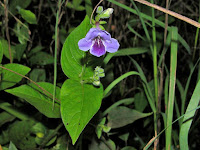



Apocynaceae : Oleander family or dogbane family.
Around 60 species in India.
Vegetative characters:
Herbs : e.g.Lochnera
Shrubs :e.g. Nerium
Trees : Alstonia
Climbers : Vallaris
or even
Lianas :Landolphia
Sometimes stems are armed with sharp spines as in Carissa.
Latex is present in unsegmented tubes and the vascular bundles are bicollateral.
Leaves are usually opposite decussate ;sometimes whorled or scattered (Plumeria).They are simple entire without stipules.
Flowers arranged in axillary or terminal cymose or panicled inflorescences ;rarely solitary.
They are bracteate, bisexual,perfect,actinomorphic,pentamerous and hypogynous.
Calyx is gamosepalous- 5 lobed.Corolla isgamopetalous 5 lobed salver shaped but sometimes campanulate/bell or funnel shaped. Stamens are distinct and as many as corolla lobes and alternate with them and adnate to the corolla tube.Filaments are short.Anthers introrse and adherent to the stigma.Gynoecium-usually bicarpellary with superior ovary ar rarely partly inferior ovary(Plumeria).When distinct each ovary is unilocular with ventral placenta.Stigma is massive variable in shape and often bilobed.
A hypogynous nectariferous disc is present which is annular,cup shaped,lobed or of distinct glands.Fruit is of two follicles dehiscing by ventral suture,sometimes berry or capsule.
Seeds are flat often winged or with a tuft of hairs at one end.
Pollination and seed dispersal:Flower is adapted for insect pollination
Apocynum :for insect pollination.
Nerium :adapted for long tongued lepidoptera.
Vinca : When insect enters its proboscis into the corolla tube it is smeared with adhesive matter and when withdrawn,it is cemented with pollens.
Winged seeds and hairs favour distribution by wind.
Economic importance and uses:
Members of the family provide a large number of ornamentals and some useful drugs.
Vinca rosea(Catharanthus roseus:Periwinkle,Sadafuli)An everblooming perennial herb with rosy purple flowers.Some anticancer drugs are extracted from it.
Thevetia peruviana:Yellow oleander,Peeli Kaner.Leafy evergreen shrub with yellow to orange flowers widely planted in gardens.Uses in rheumatism and dropsy.
Nerium indicum(Kanher)Ornamental shrub with white to pink red flowers again widely planted in gardens.
Plumeria(Frangipani,white champa,Chapha):A common garden plant with Fragrant flowers in different colours.
Tabernaemontana divaricata(Crape jasmine,Chandani:Syn.Ervatamia coromaria)white waxy flowers:common garden plant.
Carissa congesta :(Syn.C.carandas,Karaunda,Karawand.)Sweet edible fruits, widely found shrub of Sahyadris.
Rauvolfia serpentina(Sarpagandha)Found in tropical Himalayas also widely cultivated.Digitalis a common medicine for heart is procured from it.
Holarrhena antidysenterca:(Kutaj or Kuda)As the name suggests:Extract from root and bark is used in dysentery.
Wrightia tinctoria: Leaves are the source of a blue dye Indigo. Alstonia scholaris:An evergreen tree with dense crown,often planted in gardens and as avenue tree.Wood is used in packing and the bark has medicinal value.














